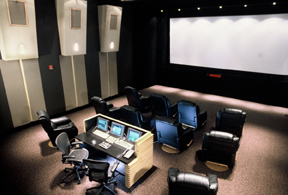| Pro-Music-News |
Installed Sound Applications
|
NT Audio Film Labs work with multiple format quality control

 NT Audio Film Labs in Santa Monica has become one of the first facilities in the world to install Lake Technology's DSP-based loudspeaker processing system, Lake Contour. NT Audio has installed multiple Lake Contour units to control the multichannel speaker system in its newly completed screening and quality control room. NT pioneered the 1/2-speed optical soundtrack negative recording process and was the first to record all four cinema sound formats on the same negative. The new screening room represents yet another NT Audio innovation, providing the unique ability to screen and QC soundtracks in all four formats simultaneously. NT Audio Film Labs in Santa Monica has become one of the first facilities in the world to install Lake Technology's DSP-based loudspeaker processing system, Lake Contour. NT Audio has installed multiple Lake Contour units to control the multichannel speaker system in its newly completed screening and quality control room. NT pioneered the 1/2-speed optical soundtrack negative recording process and was the first to record all four cinema sound formats on the same negative. The new screening room represents yet another NT Audio innovation, providing the unique ability to screen and QC soundtracks in all four formats simultaneously.
A total of nine input channels of Lake Contour processors provide essential crossover, equalization and time delay functions for the main room speaker setup. "The main room is essentially an 8.1 channel system," elaborates Shawn Jones, engineer and technologist at NT Audio, which was founded in 1983. "We're configured for left channel, left-center, center, right-center, right, and subwoofer behind the screen. Then there's a left surround, a right surround, and a rear surround channel. We have Lake Contours on every channel." Lake Contour is a two-input, six-output unit that provides not just equalization but also crossovers, dynamics and delays. Typically, a unit will be setup as two single-input, three-output modules with two- or three-way crossovers implemented, but a four-way crossover may be configured using a single unit. For the NT Audio screening room, Jones says, the Lake Contour units are each programmed differently. "Three of the Contours act as they would in a touring environment, driving the five three-way units." Those Contour units driving the surround speakers pass full-range signals but apply EQ, limiting, and other dynamics functions. "Each of the five front channels is a three-way speaker system, so the Lake Contours are being used to provide three-way crossovers and EQ," he explains. "They're also driving the subwoofer crossover and EQ." Five JBL 5671 speakers are positioned behind the screen, with ElectroVoice TL-880D subwoofers supporting the LFE channel. Uniquely for a screening room environment, Jones notes, each of the 10 surround speakers is controlled separately by the Lake Contour units. "Each of the surround speakers has its own full-range EQ and delay. The left surround channel is four speakers, with four power amps, coming out of four channels of a single Lake Contour. The right surround channel is the same. The rear surround channel is two separate speakers." The JBL SR212 units "are not surround speakers but a sound reinforcement speaker," comments Jones, a former live sound mixer and design consultant who was unhappy with the choice of theater-style surround speakers." "Allocating such comprehensive processing to each individual surround speaker is "very unusual and novel for a theater environment, but very handy," he continues. "That's one thing that I've been very happy about. Usually you have to control them in a bank: all the left surrounds get the same EQ, all the right surrounds get the same EQ. The way that rooms are setup that's usually not what is needed." Front panel controls have been kept to a minimum on Lake Contour, with most functions accessed through the Contour Controller software. "Everything is controlled from the projection booth via Ethernet, which is another handy thing," says Jones. "Typically you have to be right at the unit or use some clunky 9-pin interface. This is much nicer--and they sound great. No one even knows that they are there. They're transparent and they do what they are supposed to." Three small acoustically isolated quality control rooms located at the rear of the 40 ft. by 25 ft. screening room directly below the projection booth allow four separate audio environments to be monitored while each engineer views the same projected image. Aparia Design, an Irvine, CA-based architecture and interiors firm, led the design and coordination of the screening room project. |